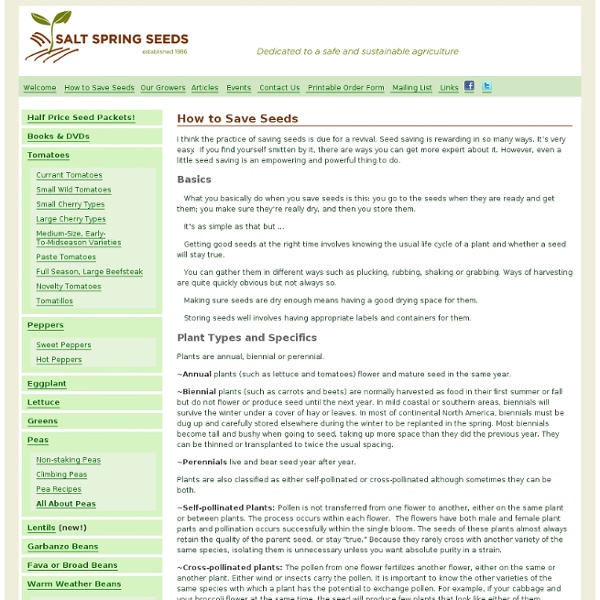Shallots, Lemon grass and Apple plants from seeds
Great video from My inspired creation. She has bought shallots,lemongrass and saved some seeds from store bought red delicious apples and has now got all of them to root. Then she can transplant to the garden and grow her own . Pretty neat. photo credit My inspired creation
NEW! MEGA Survival Kit | SeedsNow.com, INC.
The All-in-1 MEGA SEED BANK is our biggest Seed Bank - ever! What's Included: 55 varieties of crops. ↓ scroll down the page to see all ↓ 112,000+ seeds in total.Pack of seed starting soil pods so you can start your seeds indoors. Large Seed Storage Vault featuring a re-sealable vacuum sealed top (keeps seeds lasting years longer + superior moisture barrier. Pest, insect, and rodent resistant. The MEGA SEED BANK includes all of the following: Please enable JavaScript to view the <a href=" Sale Looking for our entire collection of seeds?
The best way to sprout strawberry seeds / growing strawberries
Neat way to grow strawberry plants from the seeds on the berries you buy from the store. Fragile come unarose shows how to take seeds from your strawberries that you are eating and sprout them and then transplant the little seedlings into a container till the are ready to go in to the garden. I like it, you won’t have to buy seed or starter plants again. photo credit Fragilecomeunarose
Survival Garden Seeds
The Garden Can The Preparedness Seeds Garden Vegetable Can provides a Missing link in your food storage plan. Each #10 can contains 16 popular varieties that will plant nearly 3/4 acre of garden! These Seeds are Non-Hybrid, Non-GMO and are not chemically treated. Because they are non-hybrid, seeds may be harvested at the end of the growing season and then used for the next year’s planting. 16 large seed packets sealed in a #10 can. *Varieties Included: SWEET CORN, Golden Bantam 5oz ONION, Utah Sweet Spanish 10g SPINACH, Bloomsdale Long Standing 10g WINTER SQUASH, Waltham Butternut 10g SQUASH ZUCCHINI, Black Beauty 10g RADISH, Champion 10g TOMATO, Rutgers 5g SWISS CHARD, Lucullus 10g PEA, Lincoln 10oz BEET, Detroit Dark Red 10g CABBAGE, Golden Acre 10g LETTUCE, Paris Island Cos 5g CUCUMBER, Marketmore 76 10g CARROT, Scarlet Nantes 10g PEPPER, Yolo Wonder 5g BUSH BEAN, Spike 5oz*Important – Because of the shortage of Non-Hybrid seed, substitutions may occur!
Great Vegetable Seeds from The Real Seed Catalogue
How to start plants from seed indoors to transplant in the garden later
Andrea Levy, The PD With visions of plump, juicy tomatoes, crisp cauliflower and sunny marigolds dancing in their heads, some gardeners spend late winter sowing seeds indoors and pampering their emerging beauties until it's warm enough to move them outdoors. These indoor gardeners like to get growing early for several reasons. One, a packet of a dozen or so seeds, which costs a few dollars, is a fraction of what ready-to-plant botanicals cost. "It's cheaper than buying flowering plants and vegetable starts," says Christine Harris, an Ohio State University Extension Cuyahoga County master gardener, who won the statewide award of volunteer of the year at the International Master Gardener Conference in Charleston, W.V., last year. "Costs for these have skyrocketed due to fuel costs in greenhouses and for transportation." Harris, who has been starting seeds indoors for about 13 years, says she has discovered a lot of vegetables and flowers that are not available at local greenhouses. Materials
Off Grid Info - Food Independence - Where To Get Heirloom Seeds - Non-GMO Seeds - Organic Seeds
Join 75,000+ Fans on Facebook: Follow Us On Pinterest: Please Share This Page: Here is a useful list of 40+ 230+ companies supplying heirloom / non-GMO / organic seeds. **UPDATE** This page has proven to be massively popular...! , we are gathering them up and will add them to this page as soon as we can. Please Like Off-Grid On Facebook to stay in touch and receive our latest posts! USA (states in alphabetical order) EUROPE (except UK & Ireland) South Africa All inquiries - please contact: Privacy Policy | About
Native Seeds/SEARCH - The Story of Glass Gem Corn: Beauty, History, and Hope
If you’ve spent any time online recently, you might have noticed a striking photo making its rounds. Feast your eyes on Glass Gem corn: a stunning, multi-colored heirloom that has taken Facebook and the blogosphere by storm. With its opalescent kernels glimmering like rare jewels, it’s easy to see what the buzz is about. This is some truly mind-blowing maize. For the staff here at Native Seeds/SEARCH, the viral explosion of interest in Glass Gem has been thrilling—but not surprising. Like many heirloom treasures, Glass Gem corn has a name, a place, and a story. Approaching old age, Barnes bestowed his precious seed collection to Greg Schoen, his corn-breeding protégé. The story of Barnes, Schoen, and their remarkable corn is not unusual. The bounty of genetic diversity our ancestral farmers and gardeners created in this way was shared and handed down across generations. Though much of this diversity may be gone, all hope is not lost. To Purchase Glass Gem Seed:



